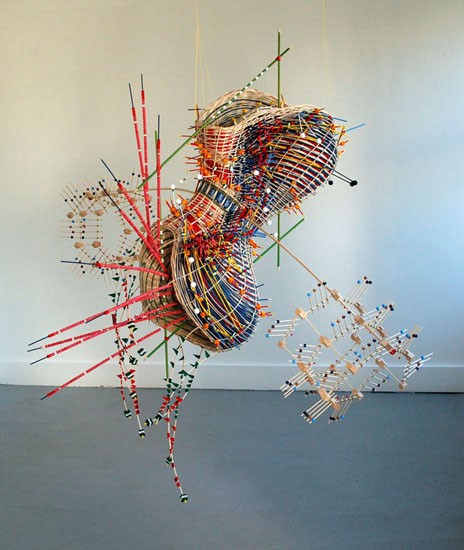“Warm Winter”, Nathalie Miebach (USA)

Title of the artwor: Warm Winter
Author: Nathalie Miebach
Date: 2007
Source: http://nathaliemiebach.com/weather07.html
ARTWORK ABSTRACT IN WORDS OF THE ARTIST
My work focuses on the intersection of art and science and the visual articulation of scientific observations. Using methodologies and processes from both disciplines, I translate scientific data related to ecology, climate change and meteorology into three-dimensional structures. My method of translation is primarily weaving, in particular, basket weaving, as it provides me with a simple but highly effective grid through which to interpret data in three-dimensional space. Central to this work is my desire to explore the role that visual aesthetics play in the translation and understanding of scientific information. By using artistic processes and everyday materials, I am questioning and expanding the traditional boundaries through which scientific data has been visually translated (e.g., graphs, diagrams), while at the same time provoking expectations about what kind of visual vocabulary is considered in the domain of ‘science’ or ‘art’.
Sound and musical notation are other ways in which I translate and explore the behavior of weather data. I translate meteorological data into musical scores that are constructed entirely from meteorological data, but integrate human experiences and interpretations of meteorological events. The juxtaposition of objective data and more nuanced, subjective readings of weather lead to a musical/sculptural translation that explores how human emotions and experiences influence the perception of weather. These musical scores are then translated into woven sculptures. At the same time, they are also used in collaborations and numerous commissioned works by emerging composers and have been performed in 14 concerts in the US and Canada. My collaborations with composers and musicians are twofold: to convey a nuance or level of emotionality around my research that I find more difficult to achieve through my sculptures, and to reveal patterns or stories in the data that musicians might identify that I have not been able to see.
Starting in 2006, I began building low-tech data collection devices that extract weather data from specific environments. Living on Cape Cod at the time, I went to Herring Cove Beach for 18 months every day, rain or shine, to observe and record the interaction between the weather and the environment. The data was then compared to historical and global weather trends and ultimately translated into a series of sculptures.
GET INSPIRED
WHAT DOES THIS WORK TRANSMIT TO US?
What materials / media are used in the work and why?
Warm Winter. Reed, wood, data, 6’x 5’x6′, (2007) Using a 24-hour basis, this piece converts locally collected data (at Herring Cove), with data from regional buoys (source: Gulf of Maine Observing System) and historical data (source: www.wunderground.com, NOAA and U.S. Naval Observatory). The converted data include temperature (air, water, ground), wind speed and direction, tides, and moon phases. The translated time period is from December 2006 to January 2007. It is of a sculptural-installationist type.
What is the significance of the elements of the work?
This work offers us two narratives and metaphors play an important role in creating an overlapping approach to building narratives with data, while suggesting a parallel, futuristic and more Dantesque perspective. The first is a scientific narrative, composed of temperature, wind and pressure gradients that generate energies to build storms and propel them forward. It is the center of a climatic event, exploring the dissonance and coexistence between the physics of extreme weather and the various human responses as the changing climatological state progresses, sometimes resulting in flood-like inclement weather that impacts human lives. Precisely the latter is a narrative filled with human experiences during and after natural catastrophes associated with climate change. This provides emotional perspectives through which storms are also interpreted and shows artists and scientists lessons from them. In this sense we should be concerned about the simplicity with which real facts about the environment are sometimes shown, and while adaptation to the environment is crucial, so are both narratives if climate change and its effects on human and terrestrial life are to be accepted.
About the artist
Nathalie Miebach
Artwork related
Solar Beginnings of Everything that Changes

Author of the analysis: María José Romero Ternero